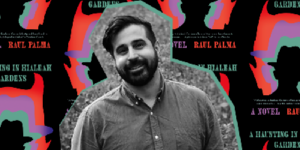Debut Novelist Raul Palma on Subverting Genre & Not Disclosing Secrets
Raul Palma‘s A HAUNTING IN HIALEAH GARDENS (Dutton) is a genre-bending debut with a fiercely political heart. Set in Miami, the novel explores what happens when Hugo Contreras, the resident babaláwo at a botanica, receives a phone call from his nemesis and debt collector, Alexi Ramirez, who is in desperate need of a spirtual cleansing. If Hugo can successfully cleanse his home before Noche Buena, Alexi will forgive Hugo’s debt. Hugo reluctantly accepts, but there’s one issue: Despite being a babaláwo, he doesn’t believe in spirits.
We spoke to Raul Palma about writing a Miami that’s rich with culture and magic, writing characters that feel authentic and compelling and how to subvert genres! Discover what he had to say below.
In your novel, you vividly depict a Miami that’s overflowing with rich culture and magic. How does place inform your writing?
 Thank you! Miami is my cultural home. As someone who grew up there, was educated by Miami-Dade Public Schools, and was raised in a Cuban exile community, I realize that there’s a very particular kind of historical and political baggage that I carry with me when I conjure up Miami. If I’m not careful, I can treat the city like a mere echo of what Miami looked like in the 80s and 90s when I was growing up—back when Tamiami Trail was two lanes!
Thank you! Miami is my cultural home. As someone who grew up there, was educated by Miami-Dade Public Schools, and was raised in a Cuban exile community, I realize that there’s a very particular kind of historical and political baggage that I carry with me when I conjure up Miami. If I’m not careful, I can treat the city like a mere echo of what Miami looked like in the 80s and 90s when I was growing up—back when Tamiami Trail was two lanes!
Modern-day Miami is incredibly complex. It is a rising global multi-ethnic and multicultural city on the brink of economic and environmental crises. One of the reasons my protagonist, Hugo, is Bolivian-American is because I wanted to, explicitly, de-center the conservative Cuban American enclave and explore how the larger Latinx community in Miami moves through the city. Telling stories about Miami—that really unpack this seismic shift in migration and expansion—is a way of making place. In shifting who narrates stories about South Florida, I ultimately seek to expand the vision of Miami’s coming community.
The challenge in writing about Miami is that it’s a city that is uniquely alive in the popular imagination—in the sorts of touristic and exceptional stories shared in popular forms of media. Even beyond contemporary media, Miami’s exceptional narratives are historical—originating in the wealthy entrepreneurs who, after Andrew Jackson’s armies murdered the indigenous people of Florida, looked at the swamps, the bugs, the nutrient-poor land, and sought to re-invent Miami as a playground for the rich, a land ripe with opportunity.
One tip for characters that feel authentic and compelling?
When my daughter was in first grade, being the responsible parent that I am, of course, I introduced her to Beavis & Butthead. She loved Beavis instantly. Specifically, she loved when he’d become the Great Cornholio and look for TP for his bunghole. One day, I picked her up from school, and she said, “Daddy! Guess what? Today in math, I was thinking about the Great Cornholio. And everyone kept asking. Why are you laughing?” At this point, I looked in the rearview mirror and said, “You didn’t tell them, did you?” And she said, “No! But I kept thinking about it. And it’s just so funny, Daddy. I wanted to share it but didn’t.”
I love this memory! It’s such an important reminder that people have rich interior lives. They don’t always share what they’re thinking, and there’s power in not disclosing secrets.
A HAUNTING IN HIALEAH GARDENS has been defined as genre-bending. How do you go about employing the elements of a genre, while also subverting them?

Dutton HC & Ebook, and Penguin Audio.
Great question! When writing a novel, I often struggle to visualize the project in its entirety because novels are so long and complex. Unlike a poem or short story, I can’t really spread a novel out on a table and get to work. When I’m preparing to revise, I need to build maps to help me visualize the way meaning is constructed in long-form narrative.
In mapping genre (and specifically when it comes to the idea of subverting any given genre), I begin by trying to disentangle my understanding of a genre into three different categories:
- The book as an object: how a cover, its descriptive text, and even title signal genre. (From the title alone, I knew readers would have gothic literature on their minds).
- The book as a story: the narrative, the writing, the vantage point, the characters, the structure—all the attributes of genre that a book signals in the way the story is told.
- The book as performed: How a narrative unfolds in the eyes of the implied audience.
Once I map out what sort of genres I’m leaning into—the kind of company my book keeps with other stories or ideas within that genre—opportunities for subversion become visible. Sometimes subversion emerges from the novel’s themes and the ways that the narrator can wink at the reader. At other times, subversion is built into the novel’s plot.
In my novel, readers of Charles Dicken’s A Christmas Carol might locate comfort in recognizing a familiar narrative structure, only to find his universally recognized story structure inverted or distorted. Ultimately, I’m deeply interested in negotiating and subverting expectations because I want to expand what it means for a story to be good.
What’s a book that still haunts you and why?

Raul Palma, Photo credit: Mix Moriaux.
In fiction, Michael Ende’s THE NEVERENDING STORY (Dutton Books for Young Readers). I always hear people talking about the scene in the movie when Artax drowns in the Swamps of Sadness, but in the book, Artax can speak. In the book, you can hear Artax articulate his own sadness and unwillingness to live on. In non-fiction, Jean Hatzfeld’s MACHETE SEASON—a book that is largely made-up of testimony from the killers who were involved in the genocide of Tutsis in Rwanda. The moments when killers try to justify or make sense of their actions are absolutely demonic.
Tell us (if you dare) – your favorite cafecito spot in Miami!
La Sin Rival Bakery on SW 8th Street and 97th Avenue. I used to drop by on my way to school—a good place for a quick cafecito and pastelito.

